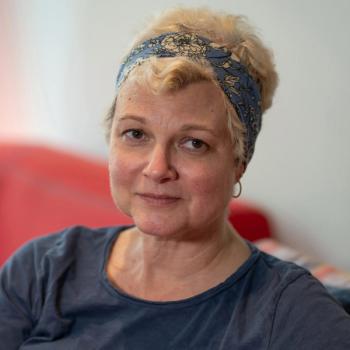
- Fall 2017
- Volume 5
- Issue 4
Tap Into the Santosha of Meditation and Release Your Cancer Stress
Be content in the present.
If the notion of trying to twist yourself into a pretzel to chant music with incense burning and sweat rolling down your face in a hot yoga room sounds ridiculous, I get you.
When I was bedridden from grueling blood cancer treatments back in 2011, one of the last things I wanted to do was physical yoga practice — and I’m a veteran yoga teacher. But there are good reasons to give yoga a go, especially if you are a cancer survivor.
“Yoga” is an umbrella term, meaning to connect or unite. Yes, it applies to physical practice, but it also refers to additional elements, such as:
- Modern mindfulness
- Ancient philosophy
- Breathing techniques
- Meditation
Yoga Philosophy 101
These elements together are what I call the wisdom of yoga. Yoga wisdom can help you heal your own mind and spirit. Unlike other practices that are done to you, including acupuncture and massage, the tools of yoga wisdom put you in charge.First things first. If you want to thrive after cancer, you need to be willing to do some self-care. That’s where Patanjali comes in.
Pa-tan-ja—who?! No, he’s not the newest one-hit wonder on Spotify.
At least 1,700 years ago, someone (or, scholars argue, several someones) in India wrote 195 pearls of wisdom —sutras — about the eight limbs, or paths, of classical yoga.
These yoga sutras are attributed to the sage, Patanjali. The first two limbs are the Yama and the Niyama. Together these guidelines (five for Yama and five for Niyama) steer us toward living a meaningful, purposeful, good life.
The first Yama, or way to live well, is Ahimsa, whose literal translation from the Sanskrit is “nonviolence.” However, it can refer to much more than that depending on how it is used. Because literal translations of Sanskrit terms do not always embody the full context, I sometimes interpret an ancient concept for our modern lives. When we think of Ahimsa as nonviolence toward others, it’s important to realize that nonviolence starts at home, with ourselves. The key concept from the first Yama boils down to this statement: Be kind, especially to yourself.
An Ancient Art
Types of Meditation
The second Niyama from Patanjali’s volume, Yoga Sutras, is Santosha, or contentment. When you meditate, set your intention to be content this minute, this hour, this day, this life. Meditation can help you release anxiety and put cancer in the background of your life. Meditation is an ancient art. People have meditated for thousands of years, and everyone from Oprah Winfrey to Lady Gaga promotes the peace of mind it brings. Folks who have never tried meditation may believe that it’s just too hard. I’m here to tell you that if you can 1) sit on a cushion on the floor or sit in a chair, and 2) breathe, you can meditate.If you’re like every other person who is in remission from cancer or living with it, you know that cancer trashes your mind with worry. There are several types of meditation that can help, including:
- Guided meditation
- Mindfulness meditation
- Moving meditation
- Breath meditation
When an instructor, whether live or recorded, talks you through a meditation, it’s called guided meditation. If you sit, whether on the floor or in a chair, for mindfulness meditation, you focus on your natural breath to clear your mind. For those who are too antsy to stay still, moving meditation, such as mindfully walking, biking, swimming or hiking, is a great option. With breath meditation, you consciously alter your natural breath to help your mind focus and concentrate.
For many people, thoughts of progression, recurrence or a new cancer come on strong right before sleep. They did for me. Meditation can be a wonderful way to calm your mind and help you rest. Calming breath meditation helps your body release tension with each longer exhalation.
Meditation is a gem to have in your treasure chest of self-care. Try different types and see what works for you.
To try calming breath meditation, follow these steps:
- Take a seat on a cushion on the floor with your legs crossed or sit on the front edge of a chair with feet flat on the floor.
- Root down into your seat as you lengthen up through your spine.
- Rest your hands on your thighs and close your eyes.
- Inhale deeply through the nose to the count of 2: 1…2….
- Exhale fully through the nose from 4 to 1: 4…3…2…1…
- Stay with this calming breath or lengthen the exhalation from 8 to 1: 8…7…6…5…4…3…2…1…
- Continue meditating on the breath until you feel calm, anywhere from 30 seconds to several minutes.
- Complete your final exhalation, return to your natural breath and gently open your eyes.
If, during this exercise, you ever feel lightheaded or dizzy, please immediately return to your natural breath and open your eyes.
Try Every Day
Try this every day for a week with a 35-minute goal. Start with a five-minute session and lengthen each day.The purpose of meditating is not to reach enlightenment the first, fifth, or 100th time out (kudos to you if you do, don’t get me wrong). Instead, the art of meditation is a lesson in trying. You try, you fail, you try, you fail, you try … you feel a moment of utter peace and calm … then your nose itches. Oh well. You try again.
Once you’ve found a meditation type that suits you, dive in. If you have time to brush your teeth, you can fit meditation into your day, so no more excuses! Start meditating every day to develop a good habit.
How long will it take for meditation to stick? It could be two weeks, three weeks or six weeks, depending on which good habit-forming scientist you read. Some days a five-minute session might seem like forever. Other times you may feel as if the moments fly by. Either way, feel good that you’re treating yourself well.
Erin Michaela Sweeney is a cancer "thriver" and yoga teacher who writes and speaks to empower cancer survivors with new ways to live their best lives. She is writing a book about how you can thrive beyond cancer.
Articles in this issue
about 8 years ago
Celebrate Life as a Survivorabout 8 years ago
Poet Momabout 8 years ago
Managing Work-Life Balance After Cancer Treatmentabout 8 years ago
Documentary Features Wisdom from Cancer Survivorsabout 8 years ago
An Evolution of Complementary Cancer Therapyabout 8 years ago
Complementary Therapies for Cancer Treatment Are Coming of Age




